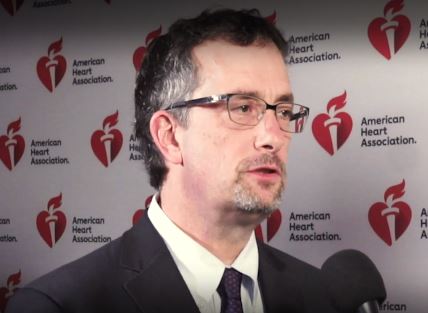User login
PHILADELPHIA – The eagerly awaited results of the ISCHEMIA trial – the largest-ever randomized trial of an initial invasive versus conservative management strategy for patients with stable ischemic heart disease – were emphatically declared practice-changing by interventional cardiologists and noninterventionalists alike at the American Heart Association scientific sessions.
At a median 3.3 years of follow-up of 5,179 participants with baseline moderate or severe ischemia at 320 sites in 37 countries in ISCHEMIA (International Study of Comparative Health Effectiveness with Medical and Invasive Approaches), an initial invasive strategy accompanied by optimal medical therapy (OMT) didn’t reduce the risk of the primary composite endpoint of cardiovascular death, MI, hospitalization for unstable angina, heart failure, or resuscitated cardiac arrest, compared with a conservative strategy of OMT alone. The rates at 4 years were 15.5% with the conservative strategy and 13.3% with the invasive strategy, reported study chair Judith S. Hochman, MD, professor of medicine and senior associate dean for clinical sciences at New York University.
Nor was there a significant between-group difference in the major secondary endpoint of cardiovascular death or MI: 13.9% with the conservative strategy, 11.7% with invasive management.
“The probability of at least a 10% benefit of the invasive strategy on all-cause mortality was less than 10%, based on a prespecified Bayesian analysis,” she added.
Prior to enrollment and randomization, CT angiography was routinely performed to rule out left main coronary artery disease.
Fifty-four percent of participants in the National Heart, Lung, and Blood Institute–funded trial had severe ischemia on a baseline noninvasive stress test. To the investigators’ surprise, patients with more severe ischemia or more extensive multivessel involvement didn’t do better with the invasive approach.
Almost a quarter (23%) of patients in the conservative management group crossed over to revascularization within 4 years.
Quality-of-life results
An invasive strategy did result in significantly greater improvement in angina control and quality of life, as measured using the Seattle Angina Questionnaire, than OMT alone in patients who had angina at least once a month at baseline.
“We have 100% confidence that there is a treatment benefit associated with an invasive approach early as well as late after randomization,” said John A. Spertus, MD, coprincipal investigator for the ISCHEMIA quality of life analysis.
Indeed, he calculated that, for patients with weekly angina, the number needed to treat with revascularization instead of OMT alone for one to be angina-free at 3 months was three.
However, in the 35% of ISCHEMIA participants who reported no angina within the past month at baseline, the invasive strategy offered no quality of life advantage, he added.
“I really think we need to hit ‘pause’ on asymptomatic revascularization. I just don’t see any benefit in patients without symptoms, left main disease excluded,” commented Dr. Spertus, director of health outcomes research at St. Luke’s Mid-America Heart Institute and professor of medicine at the University of Missouri, Kansas City.
The reaction
ISCHEMIA addressed a key clinical issue that’s long been surrounded by equipoise because of a paucity of high-quality data. As such, it was deemed worthy of its own AHA Late-Breaking Science session. The assembled discussants agreed the results will change their clinical practice.
“Based on the trial results to date in the patient population studied in the trial, I as a clinician would feel comfortable advising my patients not to undergo the invasive strategy if their angina was absent or controlled or tolerated. I don’t think we should feel obligated to take them to the cath lab,” said Alice K. Jacobs, MD, an AHA past-president and professor of medicine and director of the cardiac catheterization laboratory and interventional cardiology at Boston Medical Center.
The ISCHEMIA trial has been the target of criticism because of its cost, prolonged duration, and shifting endpoints, but Glenn L. Levine, MD, praised the ISCHEMIA investigators for achieving “as well-designed and -executed a trial as one could practically do in the real world.” ISCHEMIA will undoubtedly be incorporated into AHA/American College of Cardiology guidelines on chest pain and on revascularization that are now in the process of being updated, predicted the cardiologist, who has chaired writing panels for numerous AHA/ACC guidelines.
“As someone who has been intimately involved with our national guidelines for the last 6 years, I say thank you to all the investigators and participants,” added Dr. Levine, professor of medicine at Baylor College of Medicine and director of the cardiac care unit at the Michael E. Debakey Medical Center, Houston.
“I’ll just say that this definitely will change my practice,” commented Brahmajee K. Nallamothu, MD, an interventional cardiologist and professor of medicine at the University of Michigan, Ann Arbor. “Just like the COURAGE trial taught me that not every blockage needs to have a stent in it right away, I think this is teaching me that not every patient with moderate-to-severe ischemia needs to go right away to the cath lab.”
Session cochair James de Lemos, MD, declared, “My take home is this is a remarkable finding. It’s medical proof that revascularization does not appear to have a marked effect.”
“I think the downstream implications of ISCHEMIA with regard to noninvasive testing are massive. I think that’s where will see more of an impact in our practice,” according to Dr. de Lemos, professor of medicine at the University of Texas Southwestern Medical Center and chief of the cardiology service at Parklawn Hospital in Dallas.
Numerous panelists expressed hope that the National Institutes of Health will fund a long-term extension of ISCHEMIA to learn if the results hold up.
The ISCHEMIA trial was funded by the National Heart, Lung, and Blood Institute. Dr. Spertus holds the copyright for the Seattle Angina Questionnaire.
SOURCE: Hochman JS. AHA late breaker.
PHILADELPHIA – The eagerly awaited results of the ISCHEMIA trial – the largest-ever randomized trial of an initial invasive versus conservative management strategy for patients with stable ischemic heart disease – were emphatically declared practice-changing by interventional cardiologists and noninterventionalists alike at the American Heart Association scientific sessions.
At a median 3.3 years of follow-up of 5,179 participants with baseline moderate or severe ischemia at 320 sites in 37 countries in ISCHEMIA (International Study of Comparative Health Effectiveness with Medical and Invasive Approaches), an initial invasive strategy accompanied by optimal medical therapy (OMT) didn’t reduce the risk of the primary composite endpoint of cardiovascular death, MI, hospitalization for unstable angina, heart failure, or resuscitated cardiac arrest, compared with a conservative strategy of OMT alone. The rates at 4 years were 15.5% with the conservative strategy and 13.3% with the invasive strategy, reported study chair Judith S. Hochman, MD, professor of medicine and senior associate dean for clinical sciences at New York University.
Nor was there a significant between-group difference in the major secondary endpoint of cardiovascular death or MI: 13.9% with the conservative strategy, 11.7% with invasive management.
“The probability of at least a 10% benefit of the invasive strategy on all-cause mortality was less than 10%, based on a prespecified Bayesian analysis,” she added.
Prior to enrollment and randomization, CT angiography was routinely performed to rule out left main coronary artery disease.
Fifty-four percent of participants in the National Heart, Lung, and Blood Institute–funded trial had severe ischemia on a baseline noninvasive stress test. To the investigators’ surprise, patients with more severe ischemia or more extensive multivessel involvement didn’t do better with the invasive approach.
Almost a quarter (23%) of patients in the conservative management group crossed over to revascularization within 4 years.
Quality-of-life results
An invasive strategy did result in significantly greater improvement in angina control and quality of life, as measured using the Seattle Angina Questionnaire, than OMT alone in patients who had angina at least once a month at baseline.
“We have 100% confidence that there is a treatment benefit associated with an invasive approach early as well as late after randomization,” said John A. Spertus, MD, coprincipal investigator for the ISCHEMIA quality of life analysis.
Indeed, he calculated that, for patients with weekly angina, the number needed to treat with revascularization instead of OMT alone for one to be angina-free at 3 months was three.
However, in the 35% of ISCHEMIA participants who reported no angina within the past month at baseline, the invasive strategy offered no quality of life advantage, he added.
“I really think we need to hit ‘pause’ on asymptomatic revascularization. I just don’t see any benefit in patients without symptoms, left main disease excluded,” commented Dr. Spertus, director of health outcomes research at St. Luke’s Mid-America Heart Institute and professor of medicine at the University of Missouri, Kansas City.
The reaction
ISCHEMIA addressed a key clinical issue that’s long been surrounded by equipoise because of a paucity of high-quality data. As such, it was deemed worthy of its own AHA Late-Breaking Science session. The assembled discussants agreed the results will change their clinical practice.
“Based on the trial results to date in the patient population studied in the trial, I as a clinician would feel comfortable advising my patients not to undergo the invasive strategy if their angina was absent or controlled or tolerated. I don’t think we should feel obligated to take them to the cath lab,” said Alice K. Jacobs, MD, an AHA past-president and professor of medicine and director of the cardiac catheterization laboratory and interventional cardiology at Boston Medical Center.
The ISCHEMIA trial has been the target of criticism because of its cost, prolonged duration, and shifting endpoints, but Glenn L. Levine, MD, praised the ISCHEMIA investigators for achieving “as well-designed and -executed a trial as one could practically do in the real world.” ISCHEMIA will undoubtedly be incorporated into AHA/American College of Cardiology guidelines on chest pain and on revascularization that are now in the process of being updated, predicted the cardiologist, who has chaired writing panels for numerous AHA/ACC guidelines.
“As someone who has been intimately involved with our national guidelines for the last 6 years, I say thank you to all the investigators and participants,” added Dr. Levine, professor of medicine at Baylor College of Medicine and director of the cardiac care unit at the Michael E. Debakey Medical Center, Houston.
“I’ll just say that this definitely will change my practice,” commented Brahmajee K. Nallamothu, MD, an interventional cardiologist and professor of medicine at the University of Michigan, Ann Arbor. “Just like the COURAGE trial taught me that not every blockage needs to have a stent in it right away, I think this is teaching me that not every patient with moderate-to-severe ischemia needs to go right away to the cath lab.”
Session cochair James de Lemos, MD, declared, “My take home is this is a remarkable finding. It’s medical proof that revascularization does not appear to have a marked effect.”
“I think the downstream implications of ISCHEMIA with regard to noninvasive testing are massive. I think that’s where will see more of an impact in our practice,” according to Dr. de Lemos, professor of medicine at the University of Texas Southwestern Medical Center and chief of the cardiology service at Parklawn Hospital in Dallas.
Numerous panelists expressed hope that the National Institutes of Health will fund a long-term extension of ISCHEMIA to learn if the results hold up.
The ISCHEMIA trial was funded by the National Heart, Lung, and Blood Institute. Dr. Spertus holds the copyright for the Seattle Angina Questionnaire.
SOURCE: Hochman JS. AHA late breaker.
PHILADELPHIA – The eagerly awaited results of the ISCHEMIA trial – the largest-ever randomized trial of an initial invasive versus conservative management strategy for patients with stable ischemic heart disease – were emphatically declared practice-changing by interventional cardiologists and noninterventionalists alike at the American Heart Association scientific sessions.
At a median 3.3 years of follow-up of 5,179 participants with baseline moderate or severe ischemia at 320 sites in 37 countries in ISCHEMIA (International Study of Comparative Health Effectiveness with Medical and Invasive Approaches), an initial invasive strategy accompanied by optimal medical therapy (OMT) didn’t reduce the risk of the primary composite endpoint of cardiovascular death, MI, hospitalization for unstable angina, heart failure, or resuscitated cardiac arrest, compared with a conservative strategy of OMT alone. The rates at 4 years were 15.5% with the conservative strategy and 13.3% with the invasive strategy, reported study chair Judith S. Hochman, MD, professor of medicine and senior associate dean for clinical sciences at New York University.
Nor was there a significant between-group difference in the major secondary endpoint of cardiovascular death or MI: 13.9% with the conservative strategy, 11.7% with invasive management.
“The probability of at least a 10% benefit of the invasive strategy on all-cause mortality was less than 10%, based on a prespecified Bayesian analysis,” she added.
Prior to enrollment and randomization, CT angiography was routinely performed to rule out left main coronary artery disease.
Fifty-four percent of participants in the National Heart, Lung, and Blood Institute–funded trial had severe ischemia on a baseline noninvasive stress test. To the investigators’ surprise, patients with more severe ischemia or more extensive multivessel involvement didn’t do better with the invasive approach.
Almost a quarter (23%) of patients in the conservative management group crossed over to revascularization within 4 years.
Quality-of-life results
An invasive strategy did result in significantly greater improvement in angina control and quality of life, as measured using the Seattle Angina Questionnaire, than OMT alone in patients who had angina at least once a month at baseline.
“We have 100% confidence that there is a treatment benefit associated with an invasive approach early as well as late after randomization,” said John A. Spertus, MD, coprincipal investigator for the ISCHEMIA quality of life analysis.
Indeed, he calculated that, for patients with weekly angina, the number needed to treat with revascularization instead of OMT alone for one to be angina-free at 3 months was three.
However, in the 35% of ISCHEMIA participants who reported no angina within the past month at baseline, the invasive strategy offered no quality of life advantage, he added.
“I really think we need to hit ‘pause’ on asymptomatic revascularization. I just don’t see any benefit in patients without symptoms, left main disease excluded,” commented Dr. Spertus, director of health outcomes research at St. Luke’s Mid-America Heart Institute and professor of medicine at the University of Missouri, Kansas City.
The reaction
ISCHEMIA addressed a key clinical issue that’s long been surrounded by equipoise because of a paucity of high-quality data. As such, it was deemed worthy of its own AHA Late-Breaking Science session. The assembled discussants agreed the results will change their clinical practice.
“Based on the trial results to date in the patient population studied in the trial, I as a clinician would feel comfortable advising my patients not to undergo the invasive strategy if their angina was absent or controlled or tolerated. I don’t think we should feel obligated to take them to the cath lab,” said Alice K. Jacobs, MD, an AHA past-president and professor of medicine and director of the cardiac catheterization laboratory and interventional cardiology at Boston Medical Center.
The ISCHEMIA trial has been the target of criticism because of its cost, prolonged duration, and shifting endpoints, but Glenn L. Levine, MD, praised the ISCHEMIA investigators for achieving “as well-designed and -executed a trial as one could practically do in the real world.” ISCHEMIA will undoubtedly be incorporated into AHA/American College of Cardiology guidelines on chest pain and on revascularization that are now in the process of being updated, predicted the cardiologist, who has chaired writing panels for numerous AHA/ACC guidelines.
“As someone who has been intimately involved with our national guidelines for the last 6 years, I say thank you to all the investigators and participants,” added Dr. Levine, professor of medicine at Baylor College of Medicine and director of the cardiac care unit at the Michael E. Debakey Medical Center, Houston.
“I’ll just say that this definitely will change my practice,” commented Brahmajee K. Nallamothu, MD, an interventional cardiologist and professor of medicine at the University of Michigan, Ann Arbor. “Just like the COURAGE trial taught me that not every blockage needs to have a stent in it right away, I think this is teaching me that not every patient with moderate-to-severe ischemia needs to go right away to the cath lab.”
Session cochair James de Lemos, MD, declared, “My take home is this is a remarkable finding. It’s medical proof that revascularization does not appear to have a marked effect.”
“I think the downstream implications of ISCHEMIA with regard to noninvasive testing are massive. I think that’s where will see more of an impact in our practice,” according to Dr. de Lemos, professor of medicine at the University of Texas Southwestern Medical Center and chief of the cardiology service at Parklawn Hospital in Dallas.
Numerous panelists expressed hope that the National Institutes of Health will fund a long-term extension of ISCHEMIA to learn if the results hold up.
The ISCHEMIA trial was funded by the National Heart, Lung, and Blood Institute. Dr. Spertus holds the copyright for the Seattle Angina Questionnaire.
SOURCE: Hochman JS. AHA late breaker.
AT THE AHA SCIENTIFIC SESSIONS
Key clinical point: .
Major finding: Immediate revascularization in patients with stable ischemic heart disease provided no reduction in cardiovascular endpoints through 4 years of follow-up, compared with initial optimal medical therapy alone.
Study details: This international randomized trial included 5,129 patients with at least moderate ischemia who were assigned to initial invasive or conservative management and followed for a median of 3.3 years.
Disclosures: The ISCHEMIA trial was funded by the National Heart, Lung, and Blood Institute.
Source: Hochman JS. AHA 2019 late breaker.



